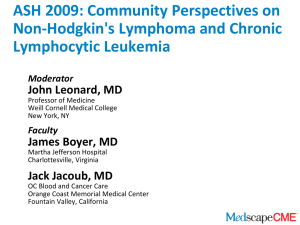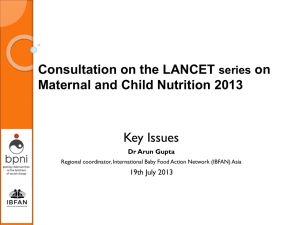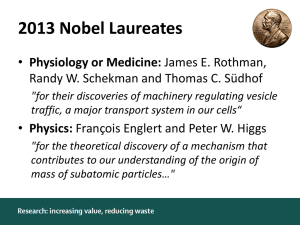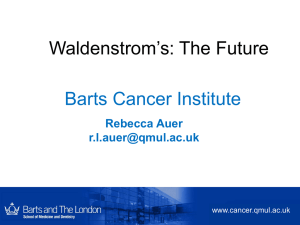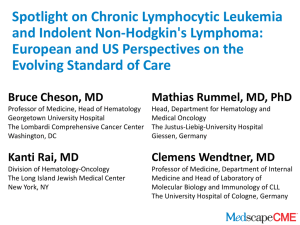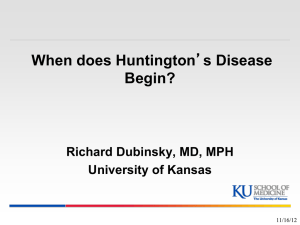2013 EHA lymphoma update
advertisement
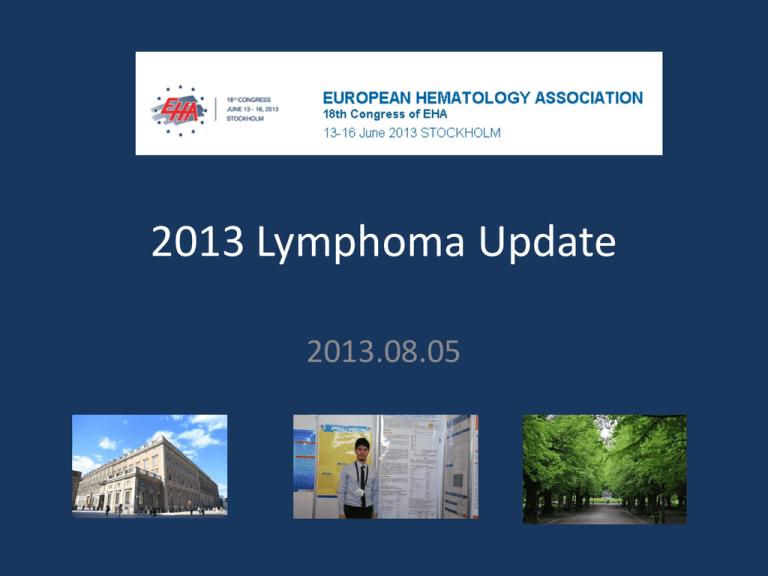
2013 Lymphoma Update 2013.08.05 Outline • Follicular lymphoma • Hodgkin’s lymphoma • Chronic lymphocytic leukemia Follicular Lymphoma Epidemiology of FL • • • • Account 22% of NHL Chronic relapsing and remitting pattern Most patients aged > 50 Median survival 12~14 years 1st line treatment in FL R-CHOP vs CHOP R-CVP vs CVP 2-yr OS 95% vs 90% (P=0.016) 4-yr OS 83% vs 77% (P=0.0290) Blood 2005;106:3725 Lancet 2013;381:1203 Standard care with indolent lymphoma • There’s still a role for watch& wait, despite new therapy modalities • Combined immuno-chemotherapy is standard of care • Rituximab maintenance as consolidation New perspectives • Which chemotherapy should be best combined with Rituximab? B-R vs R-CHOP StiL NHL 1-2003 Follicular Bendamustine-Rituximab Waldenstroms Marginal zone Mantle cell (B: 90ng/m2 day 1+2, max 6 cycles, q4wks) R Small lymphocytic (n=549) 81 centers in Germany Enrolled between Sep 2003~Aug 2008 Stage III/IV IL or MCL Median f/u 45 mos Non-inferiority study R-CHOP (max 6 cycles, q3 wks) Primary endpoint: PFS Rummel et al. Lancet 2013;381:1203 Grade 3+4 hematotoxicity B-R (n=261) (%) R-CHOP (n=253)(%) P value Leukocytopenia 37 72 <0.0001 Neutropenia 29 69 <0.0001 Thrombocytopenia 5 6 Anemia 3 5 Non-hematological toxicity B-R (n=261) (%) R-CHOP (n=253)(%) P value Alopecia 0 100 <0.0001 Paresthesia 7 29 <0.0001 Somatitis 6 19 <0.0001 Skin allergy 15 6 0.0006 Rummel et al. Lancet 2013;381:1203 Response rates B-R (n=261) R-CHOP (n=253) ORR 92.7% 91.3% CR 39.8% 30.0% SD 2.7% 3.6% PD 3.5% 2.8% P value 0.021 Rummel et al. Lancet 2013;381:1203 PFS B-R R-CHOP P value PFS 69.5 mos 31.2 mos P<0.0001 OS NR NR Rummel et al. Lancet 2013;381:1203 FL Marginal zone MCL Waldenstrom Rummel et al. Lancet 2013;381:1203 Conclusion • B-R is not only less toxic but also more effective than R-CHOP • B-R could be considered as a preferred 1st-line treatment for patients with FL, indolent and MCL Rummel et al. Lancet 2013;381:1203 Treatment strategies in IL Induction Immunochemotherapy Tumor reduction Consolidation Maintenance Eradication? PRIMA: study design PFS R maintenance (n=505) Observation (n=513) P value HR (95% CI) NR 48.3m P<0.0001 0.50 (0.39~0.64) Lancet 2010;377:42 OS R maintenance (n=505) Observation (n=513) P value HR (95% CI) NR NR P=0.60 HR 0.87 (0.51~1.47) CR or uCR after maintenance R maintenance (n=505) Observation P value (n=513) HR (95% CI) 71.5% 51.5% P=0.0001 Lancet 2010;377:42 Lancet 2010;377:42 B-R with maintenance StiL NHL 7-2008 MAINTAIN B-R + Follicular (n=611) 2 years Rituximab q2m R B-R+ 4 years Rituximab q2m Induction with B-R If CR or PR then maintenance Primary endpoint: PFS Rummel et al. Lancet 2013;381:1203 Hodgkin’s lymphoma HL is a curable disease Significant improvement in survival rate between 1970s and 1990s; However, the survival rate has plateaued in last two decades BEACOPP MOPP Stanford V 1980 GHSG HD9 study 1995 1992 ABVD 5-year survival of HL still is only 85% 2009 ABVD or BEACOPP? ABVD Most recent E2496 study BEACOPP Most recent GHSG HD15 study 3-yr PFS for advanced stage (Ann Arbor III/IV): 71% 5-yr PFS for advanced stage (Ann Arbor III/IV): 91.1% 3-yr OS: 84% 5-yr OS: 95.6% Less hematotoxicity Hematotoxicity, Infertility How to Increase efficacy ? How to increasing tolerability? JCO 2013;31:684 Lancet 2012;379:1791 Different approaches to targeting CD30 Anti-CD30 naked mAb CD30 Anti-CD30 ADCs Modified antiCD30 Ab (improving receptor affinity) CD30-directed immunotherapy Date Antibody Authors 1992 BER-H2(saponin-conjugated) Falini et al. 2005 Ki-4-131I(radio-conjugate) Schnell et al. 2007 MDX-060 (naked) Ansell et al. 2008 SGN-30 (naked) Bartlett et al. 2009 MDX-1401 (engineered) Cardarelli et al. 2010 SGN-35 (drug-conjugated) Younes et al. Brentuximab vedotin antibody-drug conjugate (ADC) Mechanism of Brentuximab vedotin Phase II trial of brentuximab vendotin in R/R HL Eligilibilty Relapsed or refractory CD30+ HL Age ≧ 12 years Measurable disease≧ 1.5cm ECOG 0~1 Prior ASCT Treatment (n=102) Follow-up Brentuximab vedotin 1.8mg/kg IV Q3W Administered outpateint over 30 mins Q3mo for 2 yrs Min.8 to max. 16 cycles for SD or better Annually after 5 years Q6 mo year 3~5 Restage at cycles 2,4,7,10,13,16 Primary endpoint: ORR by Independent review Facility (IRF) JCO 2012;30:2183 IRF (n=102) ORR, % (95% CI) CR, % (95% CI) 75 (65,83) 34 (25,44) PR, % 40 SD, % 22 PD, % 3 Not evaluable, % 1 JCO 2012;30:2183 Brentuximab (n=57) Prior therapy (n=57) P value HR 7.8m 4.1m P<0.001 0.41 JCO 2012;30:2183 Summary: changing therapeutic paradigms? Standard treatment Open questions 3rd line • Brentuximab vedotin 2nd line • HDCT+ASCT • DEXA-BEAM, mini-BEAM • ICE, DHAP, GDP Improving salvage? Introducing maintenance? 1st line • ABVD • BEACOPP New combination? GHSG approach: “targeted BEACOPP” BrECADD Medikament Bleomycin Etoposide Adriamycin BrECADD Cyclophosphamide Vincristine Brentuximab vedotin Procarbazine Prednisolone Dacarbazine 1250 Dexamethasone Comment Pulmonary toxicity 150 40 Neurotoxicity 1.8 Gonadal toxicity Cushing, infection 2×250 4×40 Chronic lymphocytic leukemia Classification of CLL patients according to their fitness Blood 2009;114:3359 History of anti-CD20 mAbs GA 101: type II, glycoenginered anti-CD20 mAb • First type II, glycoengineered , humanized IgG1 anti-CD 20 mAb • In preclinical studies comparing against rituximab, GA 101 provided: Enhanced ADCC, oligosaccharides that enhance the interaction with FcγR, particularly FcγRIIIa, even in effector cells bearing the low affinity polymorphic variant of FcγRIIIa Increased direct cell death induction Decreased complement-dependent cytotoxicity Type I and type II anti-CD20 mAbs Type I Rituximab Ofatumumab Type II Tositumomab GA 101 CDC ++ - ADCC ++ ++ Move CD20 into lipid rafts ++ - Homotypic adhesion - ++ Induced cell death - ++ Summary of direct cell death with type II mAbs (GA 101) • Most anti-CD20 mAbs in development are type I. Non of type I mAbs had proven to be superior to rituximab. • The type II anti-CD20 mAb GA101 exhibit increased PCD, enhanced ADCC and lower CDC compared with type I mAbs • GA 101 induced PCD via non-apoptotic pathways involving lysosomes nad ROS • Loss of cell surface CD20 by ”shaving” involving phagocytosis and modulation on tumor surface may affect anti-CD20 efficacy of mAbs. Thanks for your attention comments and questions
